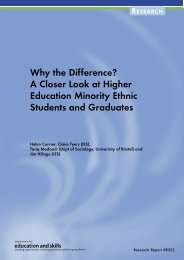Post-16 Transitions: a Longitudinal Study of Young People with ...
Post-16 Transitions: a Longitudinal Study of Young People with ...
Post-16 Transitions: a Longitudinal Study of Young People with ...
You also want an ePaper? Increase the reach of your titles
YUMPU automatically turns print PDFs into web optimized ePapers that Google loves.
had not had any subsequent contact <strong>with</strong> any pr<strong>of</strong>essional<br />
support services on completion <strong>of</strong> Year 11.<br />
Case studies – support<br />
The patterns <strong>of</strong> support available for young people post-<strong>16</strong> are<br />
complex. However, there is a sense that those who become<br />
involved in working directly <strong>with</strong> a young person do all that they<br />
can to <strong>of</strong>fer support – sometimes <strong>with</strong> considerable success. As<br />
has been outlined above, Carl 1 is a young man <strong>with</strong> severe autism<br />
who, after a period where his behavioural problems provoked<br />
something <strong>of</strong> a crisis, stayed on in his special school’s sixth form.<br />
At the time <strong>of</strong> the crisis, he was provided (through LEA funding)<br />
<strong>with</strong> a support worker who helped stabilise his behaviour and<br />
developed a strong relationship <strong>with</strong> him. In view <strong>of</strong> this, his first<br />
support worker now helps the development <strong>of</strong> Carl’s social life in a<br />
friend-like role, while a new support worker assists Carl in the<br />
classroom. When he works <strong>of</strong>f-site, he has an additional support<br />
worker to take into account the added risks involved. Now that he<br />
is preparing to leave school, Connexions and Social Services are<br />
also becoming involved in planning his future. Meanwhile, as his<br />
teacher points out, the support through which his challenging<br />
behaviour is managed is formalised through a behaviour support<br />
plan which co-ordinates the input <strong>of</strong> both pr<strong>of</strong>essionals and family:<br />
“So we do things like this here – this is a behaviour<br />
management plan that his parents have signed up to as well<br />
and everybody, but everybody associated <strong>with</strong> Carl has to<br />
follow this behaviour plan. It is very detailed about strategies<br />
to be used and works really well and <strong>of</strong> course I don’t know<br />
if the college does one but we will liaise <strong>with</strong> the college<br />
about these plans.”<br />
Both pr<strong>of</strong>essionals and parents agree that the level <strong>of</strong> support<br />
<strong>of</strong>fered to Carl is appropriate. This may well be connected to a<br />
number <strong>of</strong> factors in Carl’s case: he is in a stable environment<br />
where his needs are well-known; he falls into a well-defined<br />
disability category where eligibility for support is not in doubt; and<br />
there is a clear system for providing support. All this, <strong>of</strong> course, is<br />
in addition to the quality and commitment <strong>of</strong> the individual support<br />
workers.<br />
Other young people, however, are in somewhat different positions.<br />
Zoe, for instance, has also stayed on at her special school sixth<br />
form and, as a young person in public care and <strong>with</strong> a history <strong>of</strong><br />
abuse, receives considerable support not only from her foster<br />
parents but also from Social Services and Connexions. However,<br />
there seemed to be distinct differences <strong>of</strong> opinion between<br />
pr<strong>of</strong>essionals and family as to what Zoe’s difficulties and capacities<br />
were. The nub <strong>of</strong> the issue seems to be that Zoe has moderate<br />
learning difficulties but has also had a turbulent childhood. It is not<br />
immediately obvious, therefore, how far she lacks cognitive<br />
1 All names have been changed to protect the identities <strong>of</strong> the<br />
young people who took part in the case studies.<br />
<strong>Post</strong>-<strong>16</strong> <strong>Transitions</strong> <strong>of</strong> <strong>Young</strong> <strong>People</strong> <strong>with</strong> SEN: Wave 2 93

















